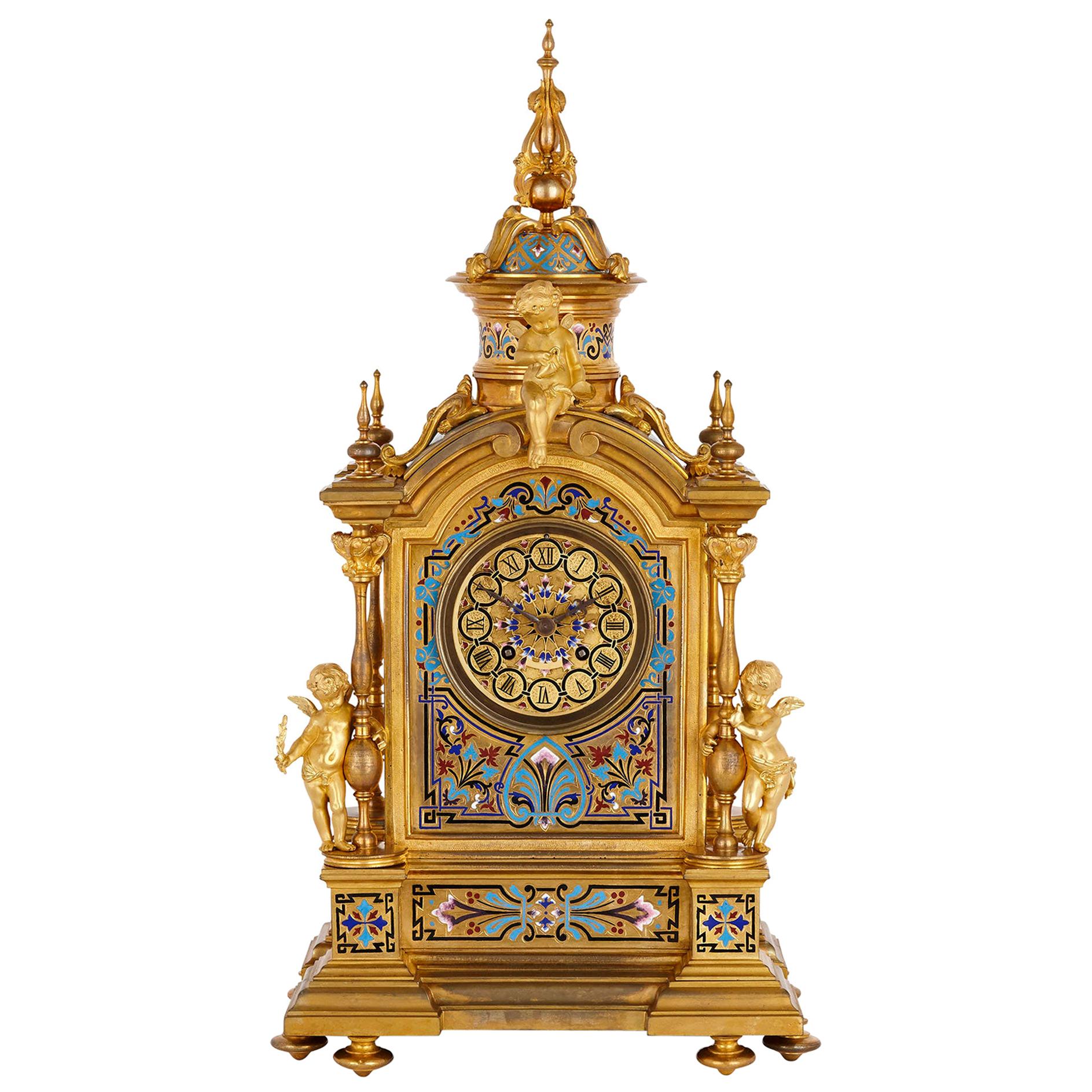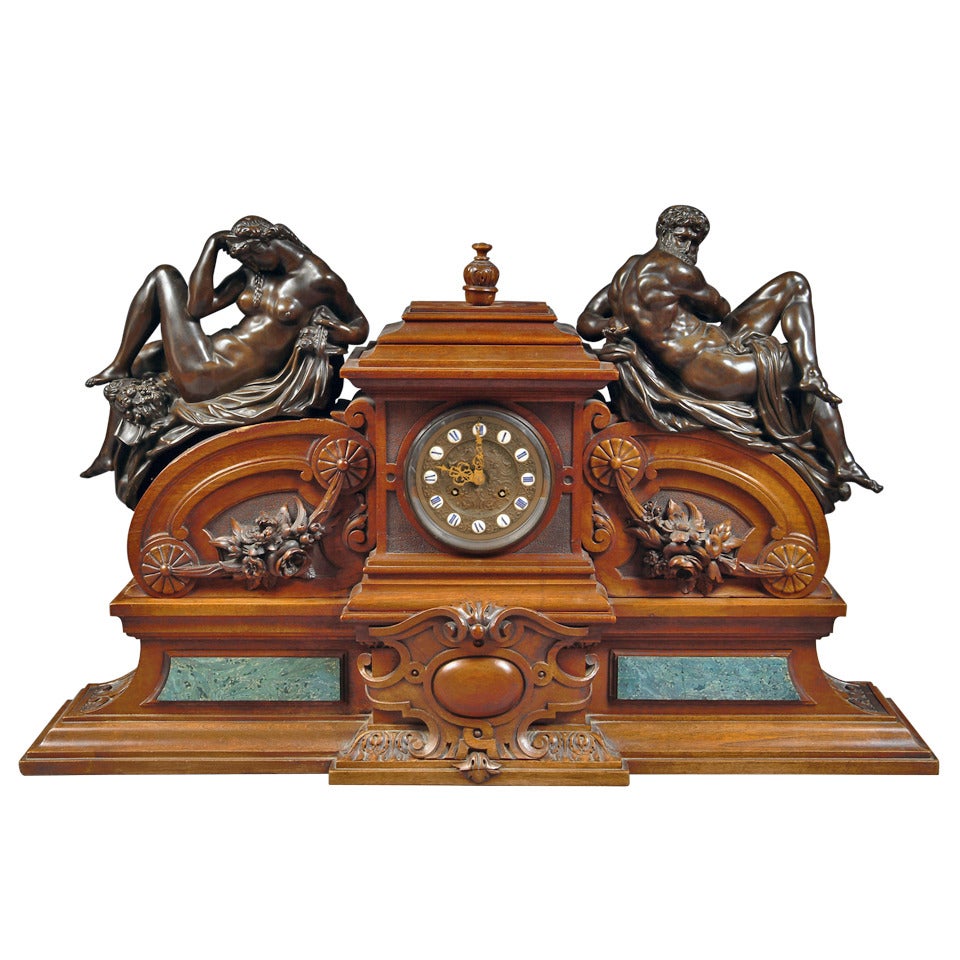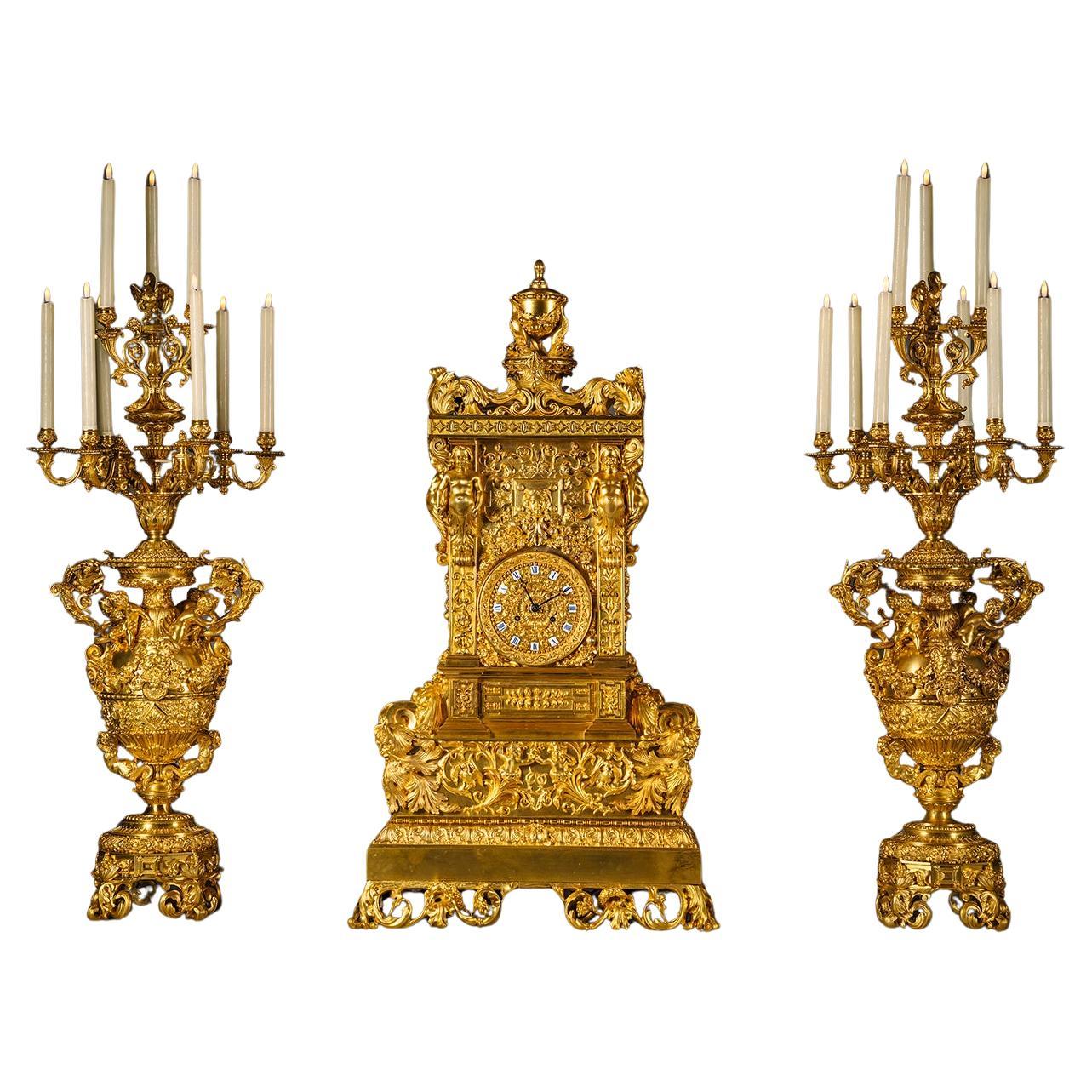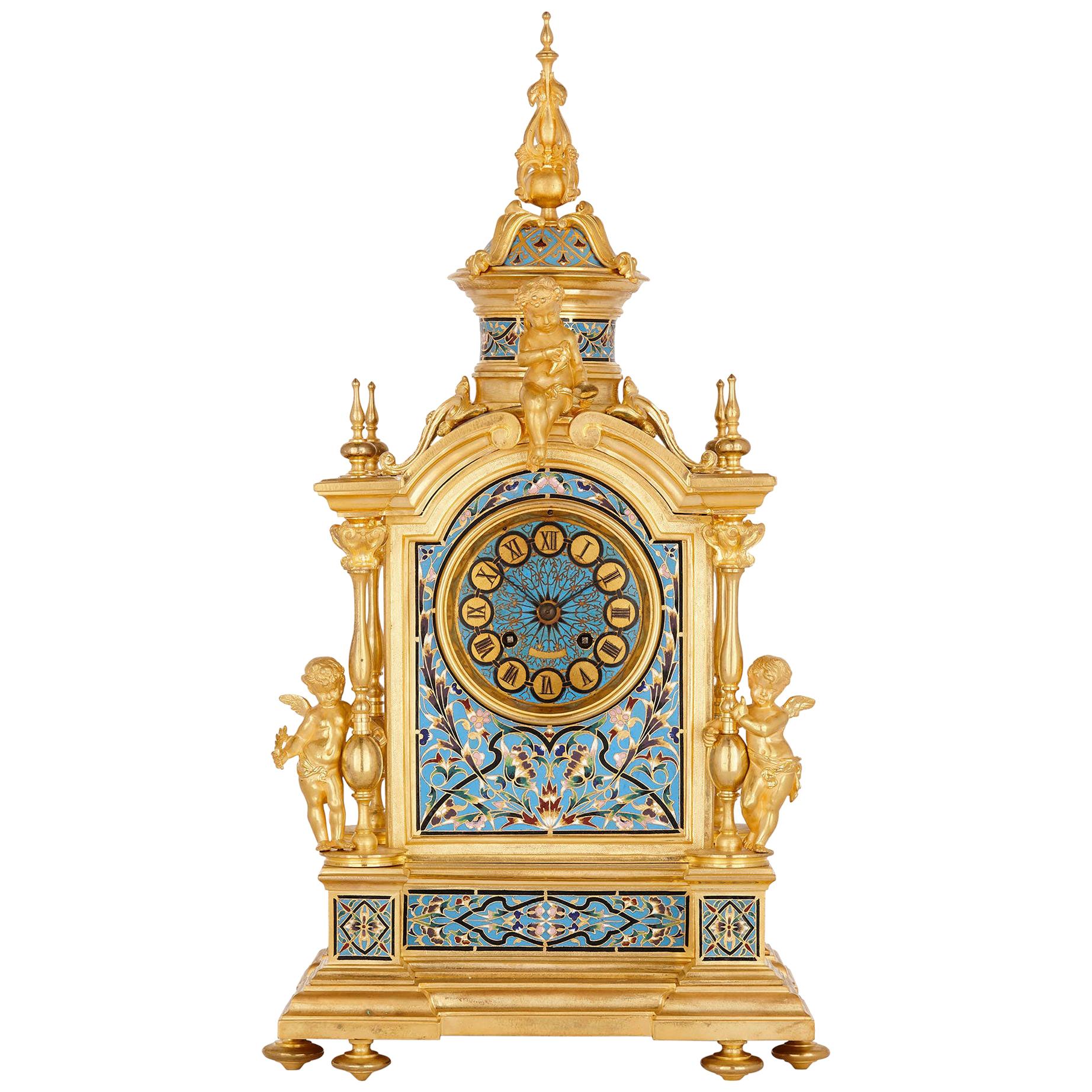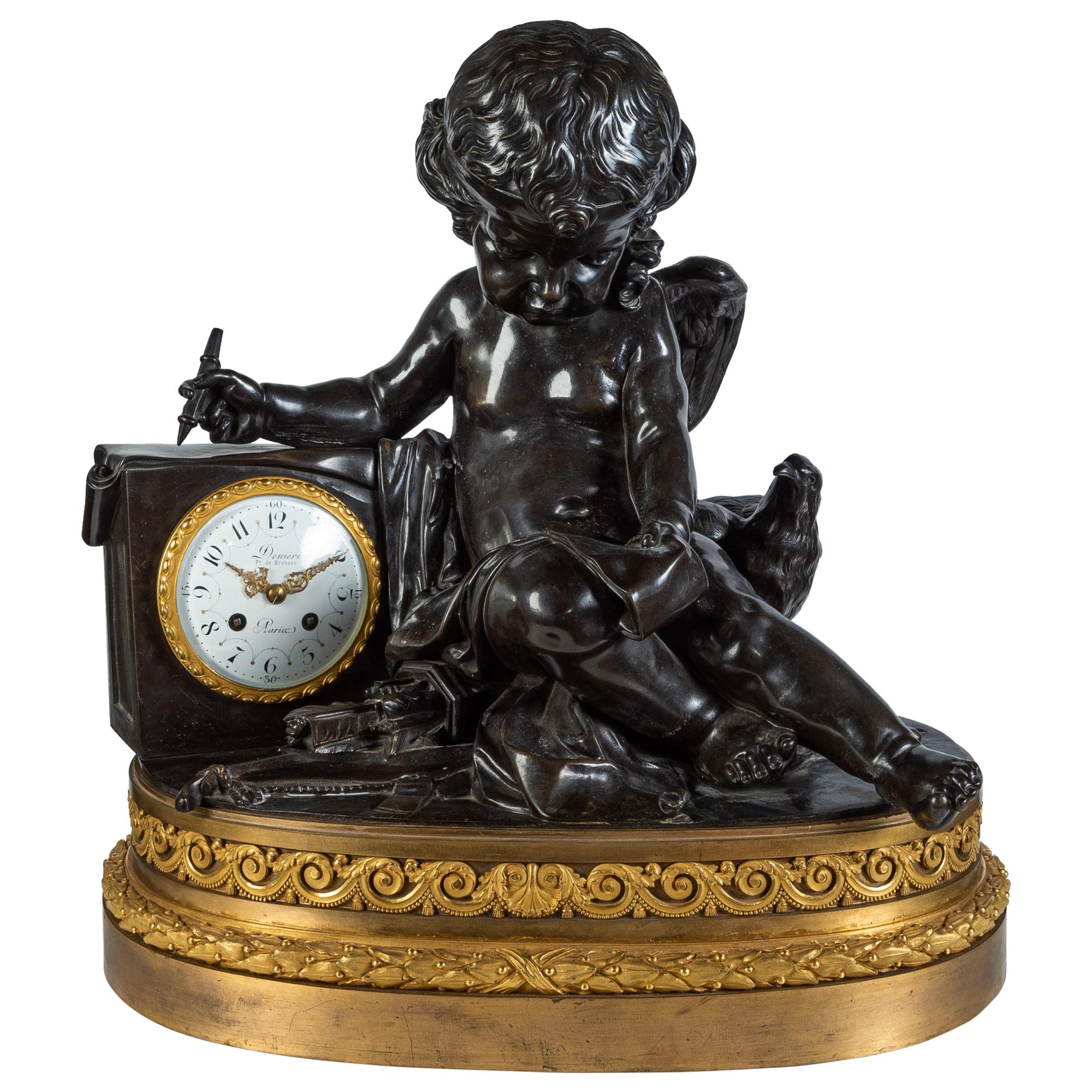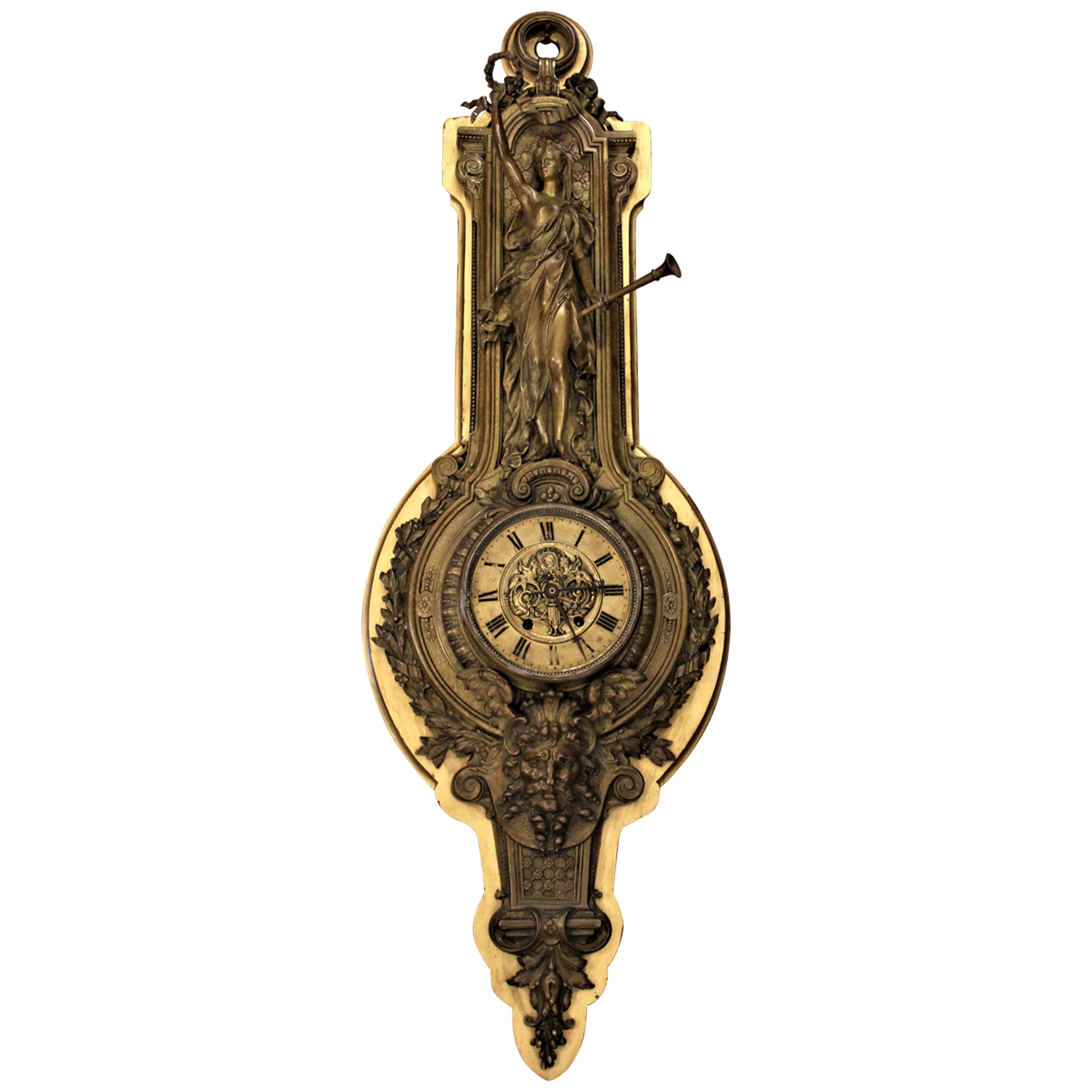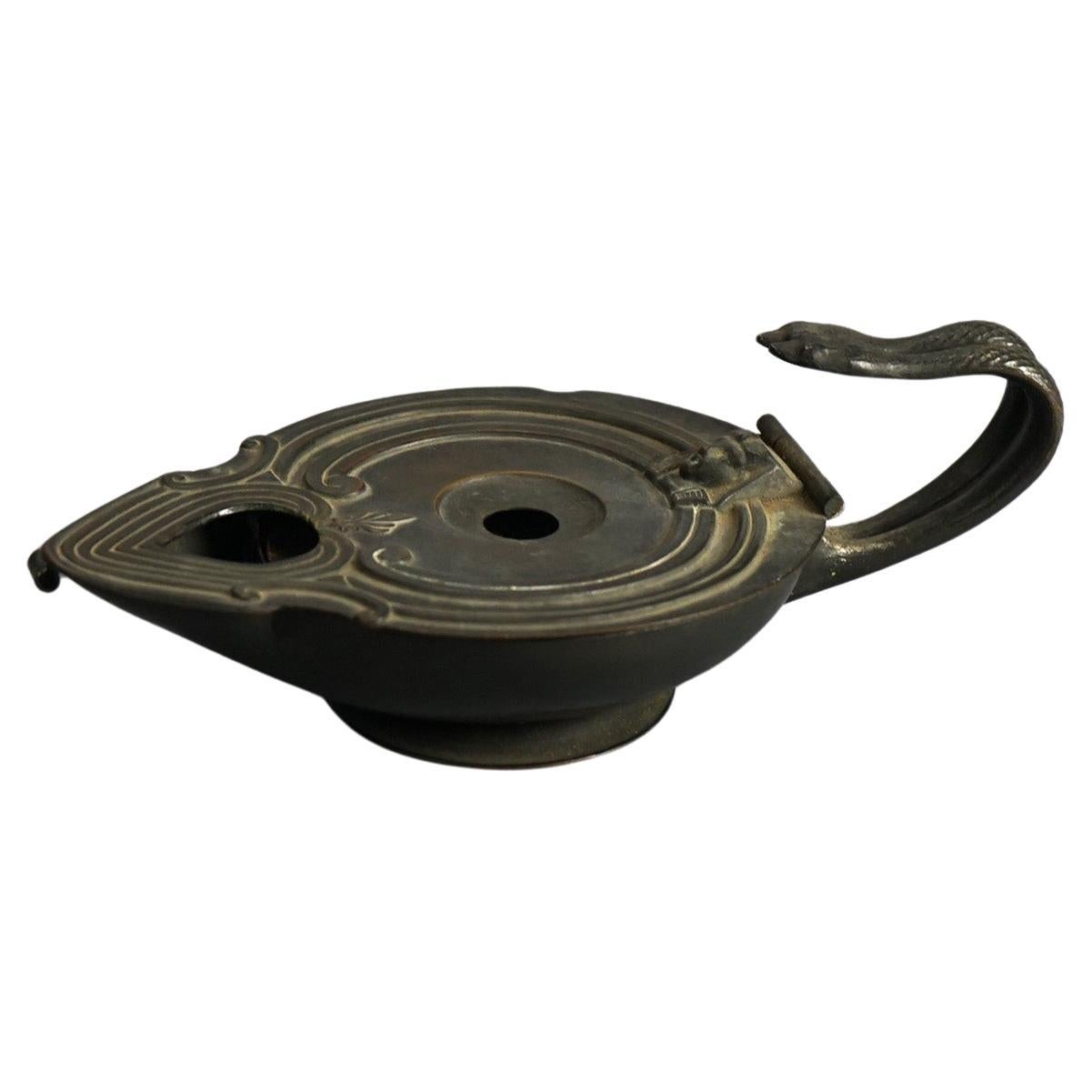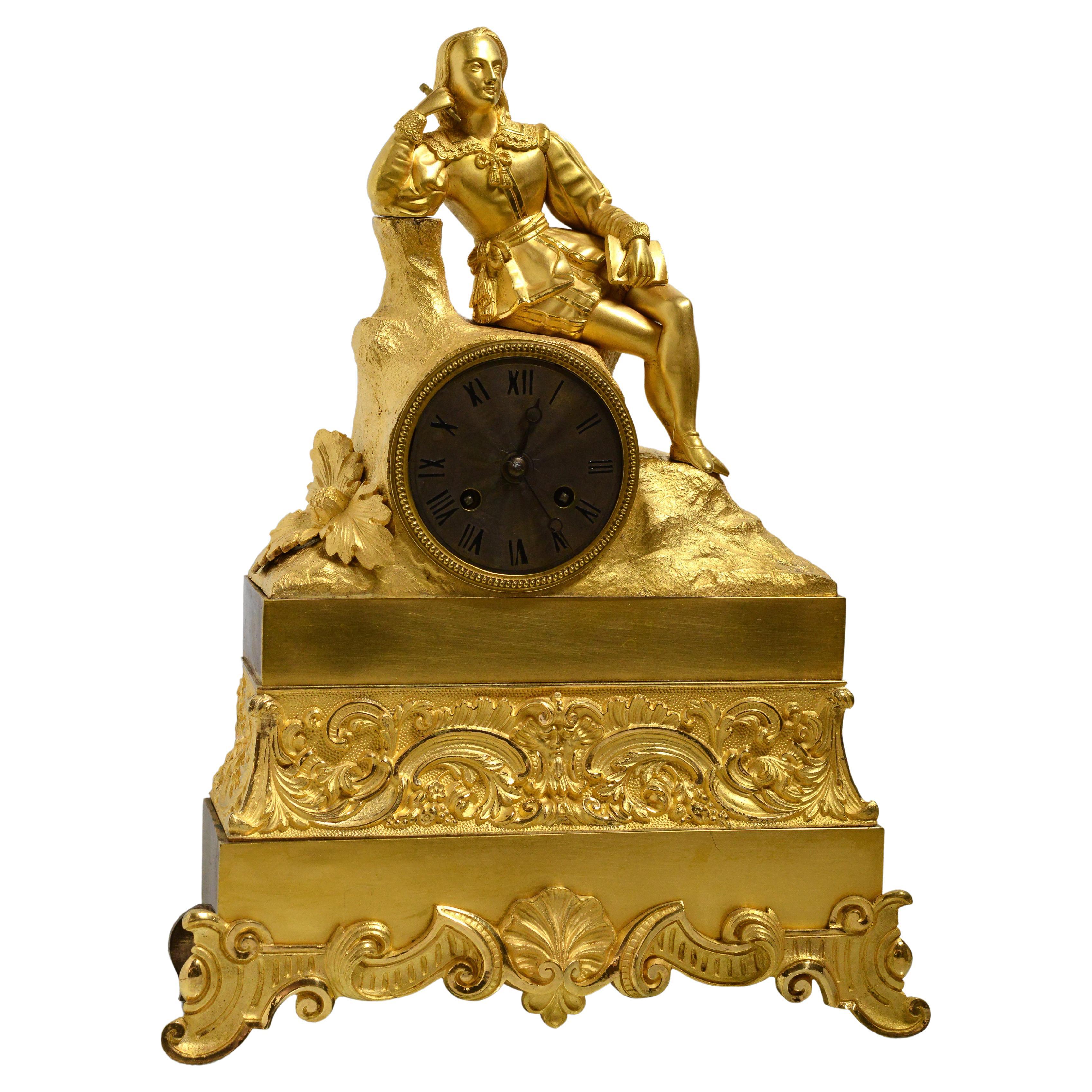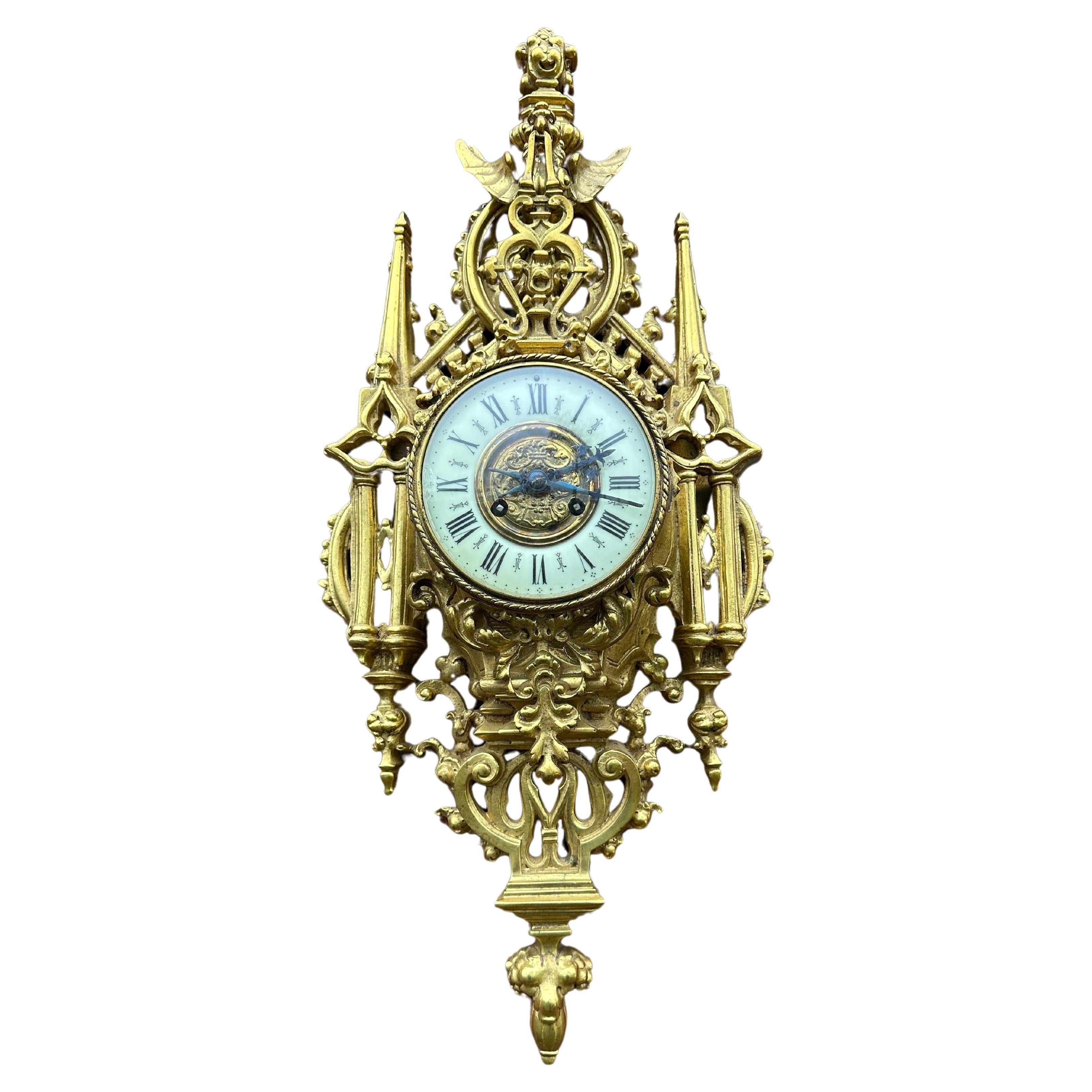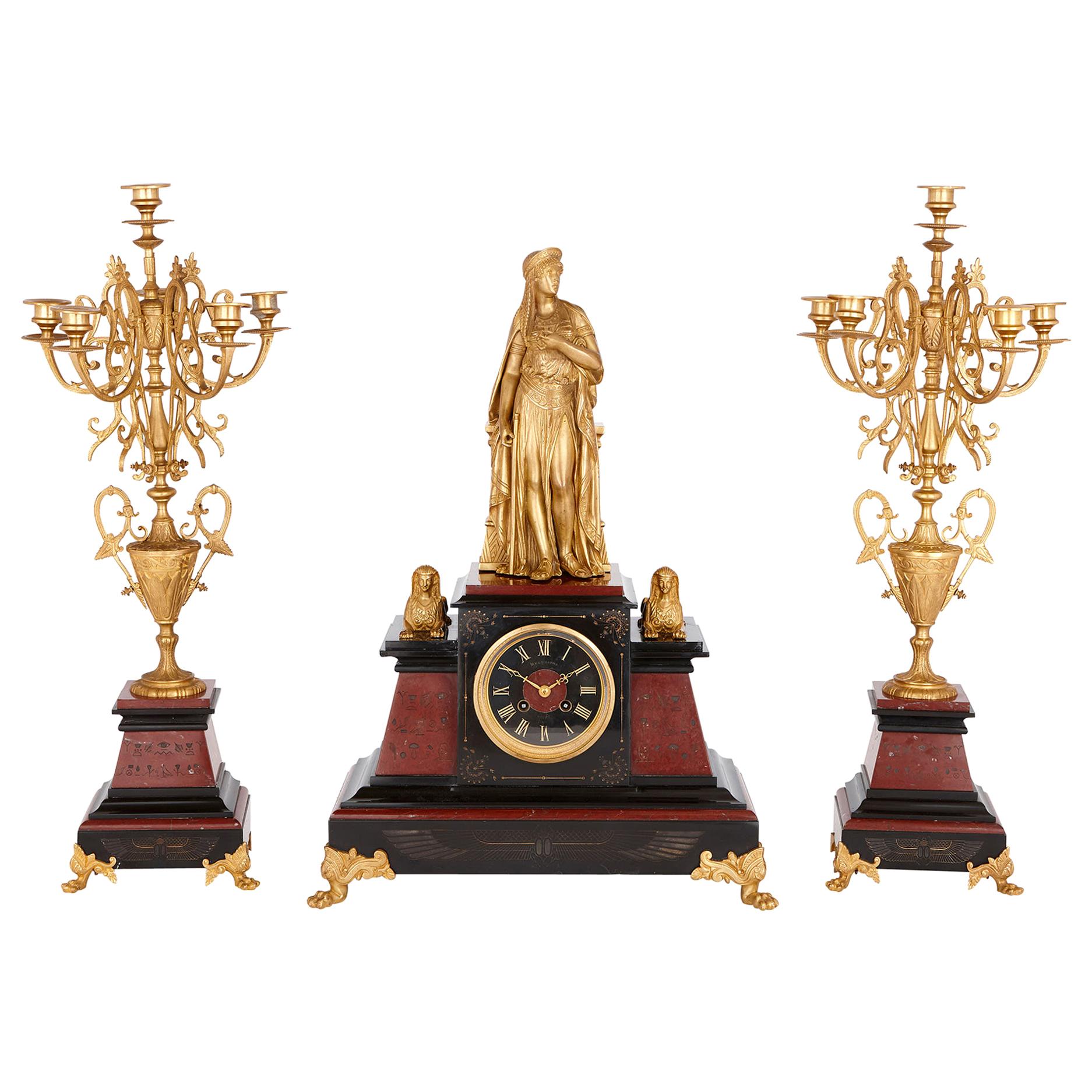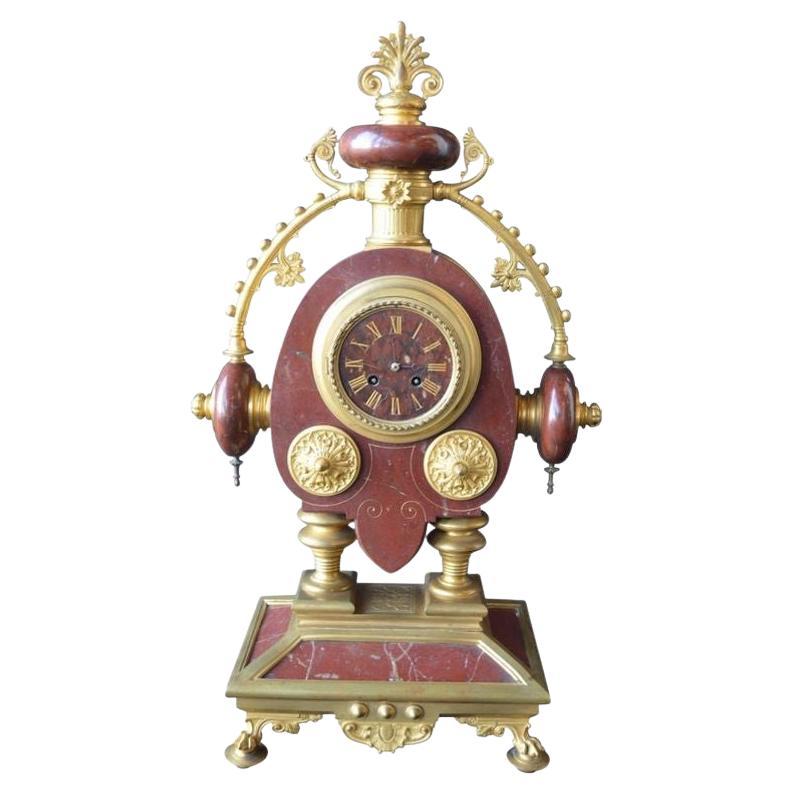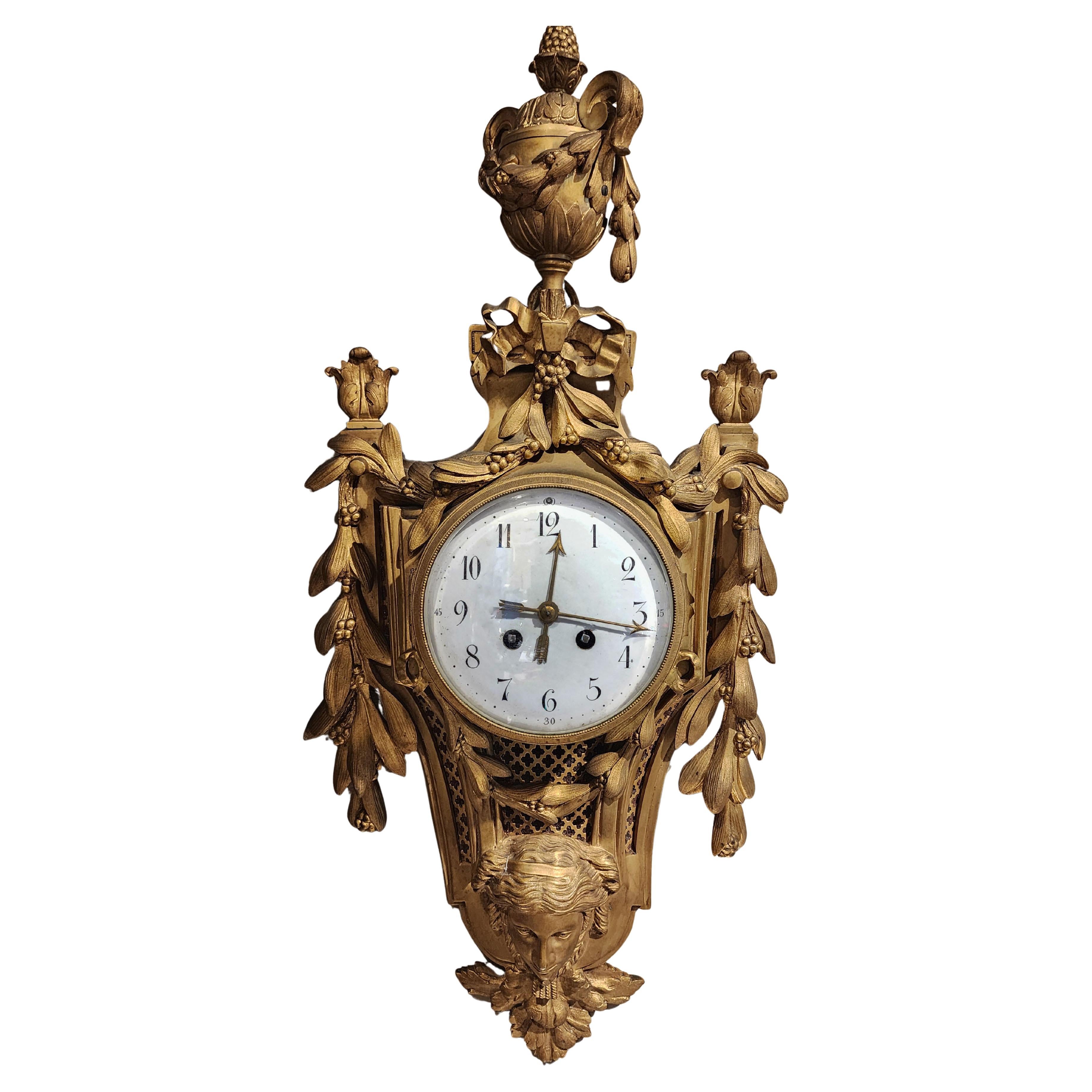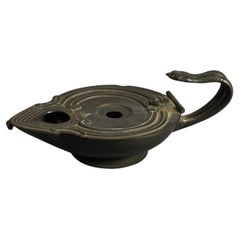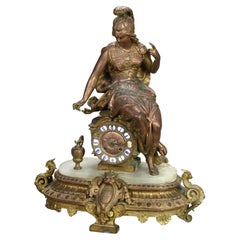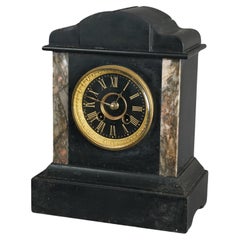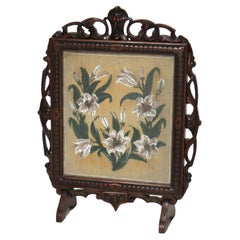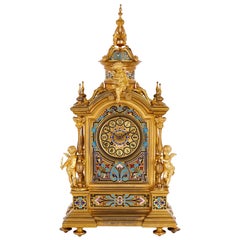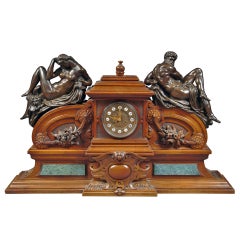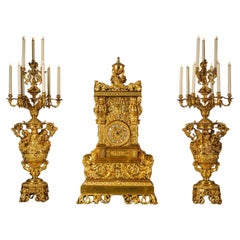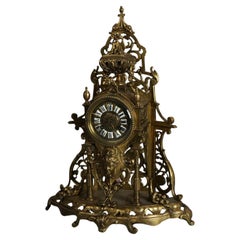
Antique Renaissance Revival Cast Bronze Figural Clock with Female Mask C1870
View Similar Items
Want more images or videos?
Request additional images or videos from the seller
1 of 12
Antique Renaissance Revival Cast Bronze Figural Clock with Female Mask C1870
About the Item
- Dimensions:Height: 18.25 in (46.36 cm)Width: 13.75 in (34.93 cm)Depth: 6.25 in (15.88 cm)
- Style:Renaissance Revival (In the Style Of)
- Materials and Techniques:
- Period:
- Date of Manufacture:c1870
- Condition:Wear consistent with age and use. Overall very good condition with loose bell and minor tarnish; unknown working condition; as photographed.
- Seller Location:Big Flats, NY
- Reference Number:Seller: 779151stDibs: LU2396339137162
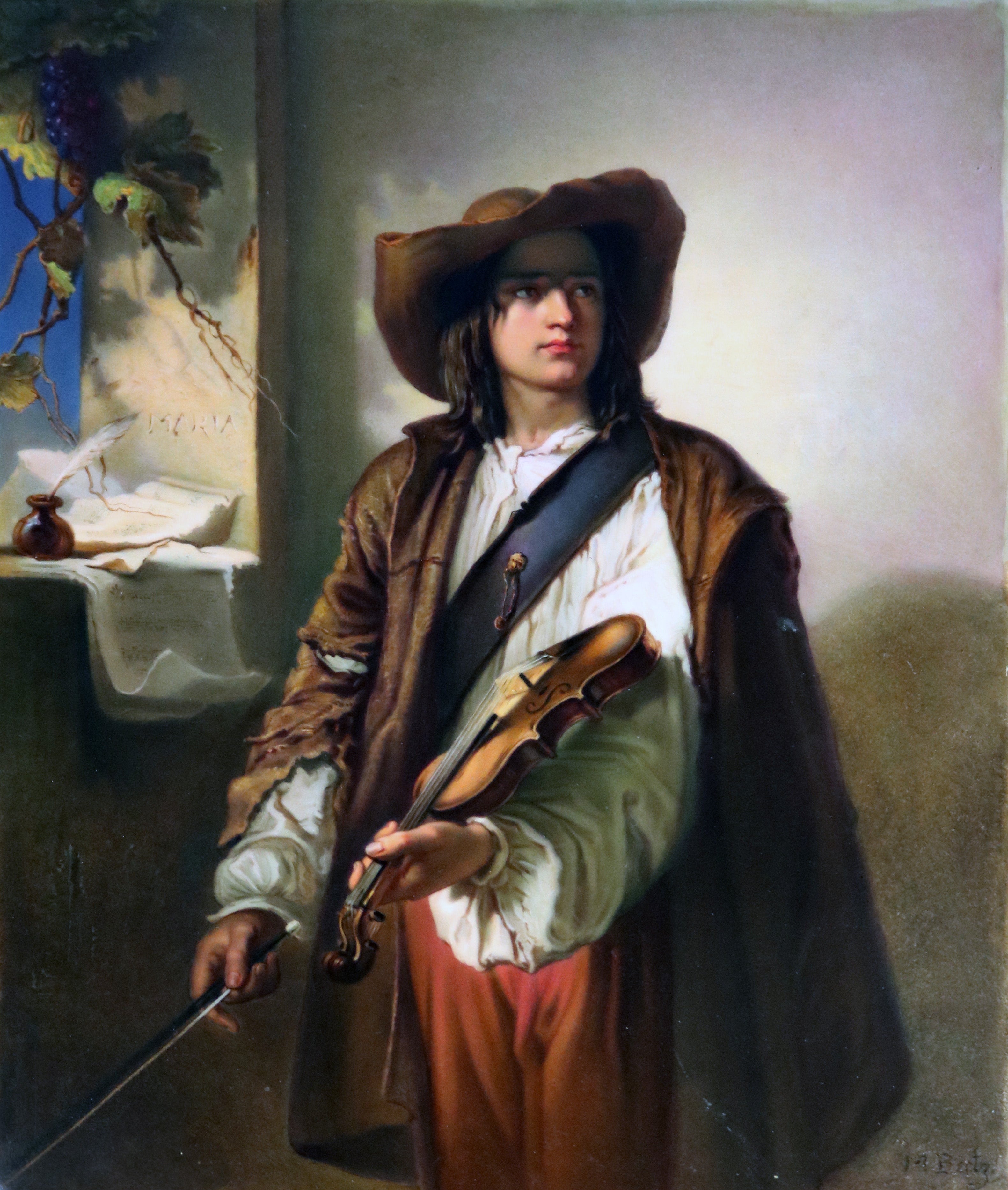
About the Seller
4.8
Gold Seller
Premium sellers maintaining a 4.3+ rating and 24-hour response times
1stDibs seller since 2016
2,668 sales on 1stDibs
Typical response time: 9 hours
Authenticity Guarantee
In the unlikely event there’s an issue with an item’s authenticity, contact us within 1 year for a full refund. DetailsMoney-Back Guarantee
If your item is not as described, is damaged in transit, or does not arrive, contact us within 7 days for a full refund. Details24-Hour Cancellation
You have a 24-hour grace period in which to reconsider your purchase, with no questions asked.Vetted Professional Sellers
Our world-class sellers must adhere to strict standards for service and quality, maintaining the integrity of our listings.Price-Match Guarantee
If you find that a seller listed the same item for a lower price elsewhere, we’ll match it.Trusted Global Delivery
Our best-in-class carrier network provides specialized shipping options worldwide, including custom delivery.More From This Seller
View AllAntique Bronze Egyptian Revival Finger Lamp c1870
Located in Big Flats, NY
Antique Bronze Egyptian Revival Finger Lamp c1870
Measures- 2.5''H x 4''W x 7''D
Category
Antique Late 19th Century Egyptian Revival Candle Lamps
Materials
Bronze
$360 Sale Price
20% Off
Antique French Bronze & Marble Figural Clock with Classical Woman 19thC
Located in Big Flats, NY
Antique French Bronze & Marble Figural Clock with Classical Woman 19thC
Measures- 19.75"H x 17"W x 7.75"D
Category
Antique 19th Century Table Clocks and Desk Clocks
Materials
Marble, Bronze
$960 Sale Price
20% Off
Antique Herschede Egyptian Revival Slate Mantel Clock Circa 1890
By Herschede Clock Co.
Located in Big Flats, NY
An antique Egyptian Revival mantel clock by Herschede offers slate case in architectural form and having marble facing, maker mark as photographed, c1890
Measures- 11.5''H x 9.25''W...
Category
Antique Late 19th Century Egyptian Revival Mantel Clocks
Materials
Slate
$760 Sale Price
20% Off
Antique Renaissance Revival Figural Carved & Needlepoint Fireplace Screen C1900
Located in Big Flats, NY
Antique Renaissance Revival Figural Carved & Needlepoint Fireplace Screen Unsigned C1900
Measures - 29.25"H x 22.5"W x 6.75"D
This exquisite antique fireplace screen from the Renai...
Category
Early 20th Century Renaissance Revival Screens and Room Dividers
Materials
Mahogany
$760 Sale Price
20% Off
Antique E. Ingraham & Co. Rosewood Figure Eight Wall Clock C1881
Located in Big Flats, NY
Antique E. Ingraham And Co. Rosewood Figure Eight Wall Clock C1881
Measures- 22.5"H x 13.75"W x 4"D
Category
Antique Late 19th Century Wall Clocks
Materials
Rosewood
$360 Sale Price
20% Off
Antique Ansonia Brass, Bronze & Crystal Clock C1890
Located in Big Flats, NY
Antique Ansonia Brass, Bronze & Crystal Clock C1890
Measures- 15"H x 7.25"W x 6"D
Category
Antique Late 19th Century Table Clocks and Desk Clocks
Materials
Crystal, Brass, Bronze
$760 Sale Price
20% Off
You May Also Like
Renaissance Revival Enamel and Gilt Bronze Mantel Clock
Located in London, GB
Renaissance Revival enamel and gilt bronze mantel clock
French, late 19th century
Size: Height 53cm, width 29cm, depth 22cm
The mantel clock i...
Category
Antique Late 19th Century French Renaissance Revival Mantel Clocks
Materials
Ormolu, Bronze, Enamel
$16,258 Sale Price
20% Off
Large French Renaissance Revival Bronze Mounted Carved Walnut Mantel Clock
Located in Los Angeles, CA
A magnificent 19th century French Renaissance Revival patinated bronze mounted carved walnut "Day and Night" mantel clock.
The dial with Roman numerals flanked by allegorical figures of night and day after Michelangelo.
France, circa 1870
Maker: Victor Paillard
The movement stamped: Vr. Paillard, Paris. Rodier Paris Stamp & Medaille Dor', 1837
Dimensions:
Height 22" (56 cm)
Width 37" (94 cm)
Depth 9" (22 cm)
Victor Paillard (1805-1886) designed and made various bronze decorative and functional objects including chenets, lighting and clocks. He also cast bronzes for some of the most important sculptors of the day including Barye, Carrier-Belleuse and Pradier
He opened his first workshop in the 1830s at 105, boulevard Beaumarchais and 6, rue Saint-Claude and by the 1850s was employing around 100 people. His success at numerous international exhibitions including the 1851 Great Exhibition (where he displayed a bronze of the Standing Sappho after Pradier) further enhanced his reputation
Day and night by Michelangelo: Though never finished, the tomb of Giuliano de' Medici in the Medici Chapel is the only one of Michelangelo great architectural-sculptural projects to be realized in a form approaching completion.
Built between 1520 and 1534, it is widely held to be one of Michelangelo's most stunning achievements.
The pose of the central figure on the tomb of Giuliano de' Medici, arms resting at his sides and legs comfortably apart, and its open composition suggest a cheerful Duke, generous in both mind and spirit. In fact, the figure holds in his hand several coins, as if an intended gift. Light plays freely on his beautiful face, yet the figure is lacking in energy and seems to wilt under the burden of the Roman armor...
Category
Antique 19th Century French Renaissance Revival Clocks
Materials
Marble, Bronze
A Monumental Renaissance Revival Clock Garniture, Attributed to Feuchère
Located in Brighton, West Sussex
A Large and Important Louis Philippe Period Gilt-Bronze Three-Piece Clock Garniture.
Attributed to the Feuchère family. The clock movement by Hémon.
In the Renaissance revival style. Comprising a clock and a pair of nine-light candelabra. The clock case of architectural out-shape with cherubic term figures supporting a rectangular pediment centred by an urn. The sides of the clock tower cast in relief with strapwork and foliage. The dial inset with enamel Roman numeral chapters. The twin-barrel clock movement with tic-tac escapement, silk suspension and countwheel strike to bell. Pendulum and winding key.
The candelabra as twin-handled vases supporting tiered branches with candle nozzles. Modelled en suite with naturalistic scrolls and foliage. Surmounted by finials modelled as an eagle toying with a serpent. The scrolled handles flanked by cherubic figures and serpents. The bodies fronted by bacchic masks and supported on socles bearing angels.
France, Circa 1835.
The clock movement signed ‘HEMON A PARIS’. The clockmaker Claude Hémon was established at rue de St. Martin circa 1810-1820.
Dimensions, the clock:
Height : 106 cm 42 inches
Width : 58 cm 23 inches
Depth : 38 cm 15 inches
Weight : 72 kg
Dimensions, the candelabra:
Height : 104 cm 41 inches
Width : 36 cm 14 inches
Depth : 36 cm 14 inches
Weight : 28 kg (each)
This magnificent clock garniture of palatial size is designed in the Renaissance revival style and dates to the Louis Philippe period. Executed in sculptural gilt-bronze with leaves, scrolls, masks and exotic birds, the naturalistic ornament represents an elaborate system of allegories and mythological iconography which recall the influence of Italian Mannerist art in France.
The distinctive design reflects a new style which replaced the neoclassism of the French Empire period. With the fall of Napoleon Bonaparte, artists and designers sought a new decorative vocabulary with which to aggrandise the Bourbon restoration. With the French revolution and Louis XVI’s execution still within living memory, it seemed too soon for a revival of the style of the Grand Siècle. Instead they looked further back to the time of François I, whose patronage of Italian artists had brought the Renaissance to France. The idea of a renaissance revival appealed to the new Bourbon monarchs and their patronage ignited great creativity in the arts.
The reigns of Louis XVIII and Charles X, who were brothers of the late King, Louis XVI, and later of Louis Philippe I, nicknamed the Citizen King, coincided with the enlightenment and the dawn of the industrial age. Great technical progress was made in metallurgy and casting which raised the art of bronze making to new heights in the hands of great masters such as Pierre-Philippe Thomire (1751-1843) and Pierre- Jean-François Denière (1774-1866).
The renaissance provided a rich and varied source book in architecture, furniture and other decorative arts for designers such as Claude Aimé Chenavard (1798-1838) whose Album de l’ornemaniste (1835) became a reference work. Léon Feuchère (1804-1857) also produced drawings of interiors, silver, bronzes and furniture and was a scion of the prominent family of bronze castors established by his grandfather Pierre-François Feuchère (1737-1823) who had worked as a gilder for the bronze caster Pierre Gouthière before setting up a bronze foundry that would become one of the largest in Paris under the management of his son Lucien-François (d. 1841) and grand-son Armand (1797-1866). A number of drawings by Léon Feuchère have recently been discovered by the Rijksmuseum and probably belonged to the collection of Louis-Philippe-Albert, duc d’Orléans, comte de Paris (1838-1894). Louis-Philippe-Albert was the grandson of the French king, Louis-Philippe I (1773-1850), who granted him the title of comte de Paris, and the son of Ferdinand-Philippe, duc d’Orléans (1810-1842). Ferdinand-Philippe was an important collector and sponsored many young artists to create metalwork objets d’art, notably a celebrated surtout de table made by Claude-Aimé Chenavard and Jean-Jacques Feuchère (1807-1852), a cousin of Armand and Léon. Principally remembered as a sculptor, Jean-Jacques Feuchère trained in the family foundry and designed small objects, cigar boxes...
Category
Antique Early 19th Century French Renaissance Revival Mantel Clocks
Materials
Bronze
Renaissance Style Gilt Bronze and Enamel Mantel Clock
Located in London, GB
Renaissance style gilt bronze and enamel mantel clock
French, late 19th century
Measures: Height 53cm, width 28cm, depth 23cm
This exquisite mantel clock is crafted in the idios...
Category
Antique Late 19th Century French Renaissance Revival Mantel Clocks
Materials
Ormolu, Bronze, Enamel
$16,258 Sale Price
20% Off
Bronze Figural Clock by Deniere, Paris, circa 1870
By Maison Deniere
Located in West Palm Beach, FL
A bronze figural clock by Deniere,
Paris, circa 1870.
Modeled as Cupid seated on his bow and quiver, a dove at his rear, the enamel dial signed Deniere Ft...
Category
Antique 1870s Mantel Clocks
Materials
Bronze
Tiffany & Co. Antique Victorian Bronze Ornately Cast Figural Wall Clock
By Tiffany & Co.
Located in Hamilton, Ontario
Signed Tiffany & Co. antique Victorian solid bronze French wall clock with an elaborate figural cast bronze case depicting at the top, a maiden holding a wreath from an outstretched hand, and a trumpet in the other. Under the clock's movement itself is a very well executed bronze depiction of Bacchus. Surrounding and accenting these two central sculptural elements to this clock case are a series of finely detailed leaf and vine motif decorations. The French chiming clock...
Category
Antique Mid-19th Century French High Victorian Wall Clocks
Materials
Bronze
Recently Viewed
View AllMore Ways To Browse
Roman Gold Medallion
Roman Bronze Plaque
19th Century French Lyre Clock
Antique Copper Bells
Green Marble Clock
Japy Freres Antique Clocks
Malachite Empire
Pink Antique Clock
Small French Antique Clock
Key Wind Clock
1860 French Circa Mantel Clock
Champleve French Clocks
Enamel Gold Putti
A And J Bell
Antique Church Bell
Antique Clocks Made In Germany
Art Deco French Mantel Clocks
Cherub Clock Candelabra
